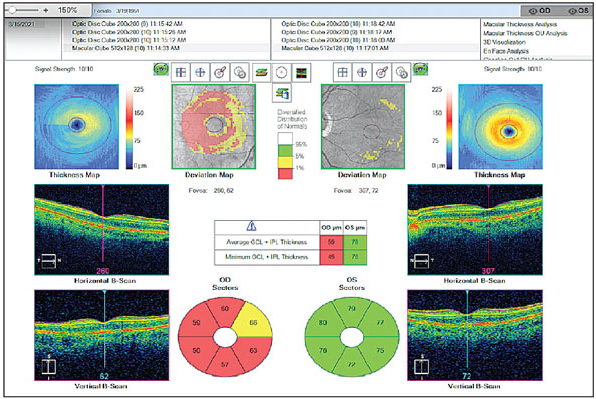 |
|
Certain structural parameters may aid in identifying glaucoma patients at higher risk of negative side effects. Photo: Judy Hu, OD Click image to enlarge. |
While visual field loss is the go-to measurement for assessing glaucoma’s visual impact, researchers believe that visual acuity (VA) is another important functional parameter affecting vision-related quality of life in patients. The team found that some macular OCT and OCT-A structural parameters, specifically ganglion cell complex (GCC) thickness, foveal avascular zone (FAZ) area and FAZ circumference, showed statistically significant associations with VA in moderate and advanced glaucoma.
The study, published in the British Journal of Ophthalmology, included 144 pseudophakic eyes with primary open-angle glaucoma. Foveal, parafoveal, perifoveal and whole-image vessel densities of the superficial and deep layers and their corresponding GCC thicknesses were obtained from OCT-A 6x6mm2 macula scans. FAZ area, FAZ circumference and foveal density-300 were measured.
In early glaucoma (55.6%), no parameter correlated with VA. In eyes with moderate to advanced glaucoma (44.4%), greater FAZ area and circumference correlated with worse VA but foveal density-300 did not. Thinner sectoral and global GCC density was associated with worse VA, except for inferior hemifield perifoveal GCC and whole-image vessel GCC density.
The investigators found a region-dependent association of vessel density obtained from different vascular layers, with deep vessel density demonstrating better correlation at the central/foveal region and superficial vessel density at the more peripheral and superior region. They suggested that this indicates the potentially differential involvement of local vasculatures in VA decline.
OCT/OCT-A parameters showed a modest ability to discriminate decreased VA, with the superior hemifield performing better than the inferior hemifield. In early glaucoma, GCC and vessel density showed similar discrimination (AUC=0.67 to 0.77). In moderate to advanced glaucoma, foveal GCC and parafoveal GCC yielded a higher AUC (0.75 to 0.81) than vessel density (0.63 to 0.72).
A modest discriminative power of superficial and deep vessel density was found for both severity groups, with a slightly weaker discrimination in the moderate to advanced glaucoma group. In contrast, OCT-measured GCC thicknesses, which performed similarly to OCT-A in the early glaucoma group, showed better discrimination than OCT-A in moderate to advanced glaucoma.
“These structural parameters may help to identify glaucoma patients at risk of impaired vision and reduced quality of life,” the authors concluded in their paper.
Wu J-H, Moghimi S, Nishida T, et al. Association of macular OCT and OCTA parameters with visual acuity in glaucoma. Br J Ophthalmol. September 9, 2022. [Epub ahead of print]. |

